ALMA says never-before-published sites are deep in heart of residential areas in Beirut, next to hospitals, restaurants, schools.
There are at least 28 missile launching sites belonging to Hezbollah in civilian areas in the Lebanese capital of Beirut, a report by ALMA Research and Education Center has found.
The report found that the never-before-published sites concentrated mainly in Hezbollah-dominated areas of Beirut are related to the launch, storage and production of the group’s Fateh 110/M600 medium-range missiles and are “the same as those subject to the Hezbollah precision-guided missile project (PGMs).”
“The world must understand and know that these launch sites are located at the heart of residential and urban civil infrastructure,” Tal Beeri, head of the Research department at ALMA Center, told The Jerusalem Post.
Israeli research center finds locations of 28 new Hezbollah missile launch sites in Beirut, Lebanon (Credit: ALMA RESEARCH AND EDUCATION CENTER)

Hezbollah, he said, is using the population of Beirut as human shields by “not hesitating to place their launch sites near public buildings, educational institutions, factories and more.”
According to the report, Hezbollah has an estimated 600 Fateh 110/M600 missiles, which have a range of up to 300 km., while improved models called “D’ Al-Ficar” have a range of up to 700 km.
Though the sites shared by the report were in Beirut, the report also stated that many missile launch sites are concentrated in south Lebanon as well as the Bekaa Valley, both Hezbollah strongholds.
The sites, which also included locations of command and control infrastructure, missile assembly, rocket-fuel storage sites and missile bunkers, were found next to high schools, clinics, hospitals, golf clubs and soccer fields, as well as the Iranian Embassy and Lebanese Ministry of Defense.


“Almost all of the sites are in southern Beirut, an area controlled by Hezbollah, and are located in civilian neighborhoods, inside private houses, medical centers, churches, industrial sites, public offices, fast food chains, as well as in open spaces nearby, hence activating the “human shield” tactic,” the report read.
And according to the report, “Based on our insight into Hezbollah’s action patterns these sites are available for immediate operational use.”

The report relied on open-source intelligence posted to Wikimapia.org, despite some of the locations having later been deleted by another user they identified as Dalany_ Mokus, who they said is likely a Russian citizen who is a supporter of the Syrian regime of Bashar Assad and its ally Hezbollah.
While the user who uploaded the locations is unknown to ALMA, they wrote that it was likely done by a government or intelligence entity “wishing to disseminate information obtained through intelligence reports, although a possibility of the user being a private individual with independent information and interest in Hezbollah’s incrimination cannot be ruled out.”

The group has expanded its arsenal with more than 130,000 rockets and missiles of all sorts of ranges and payloads. And while it mostly comprises small, man-portable and unguided surface-to-surface rockets and missiles with ranges of between 10 km.-500 km., the group is continuing to work on its precision-missile project.
As such, despite the effort and years invested, the organization has only several dozen such missiles.
Israel has reiterated several times that the transfer of any advanced weapons to Hezbollah is a redline for the Jewish state and that it will work to prevent any such movement.
Hezbollah’s project to build accurate and precise missiles, which is done using Iranian know-how, funding and guidance, has been targeted by Israel on numerous occasions in Syria, and according to foreign reports in Iraq and Lebanon as well, as part of its war-between-wars campaign.
 Eurasia Press & News
Eurasia Press & News



